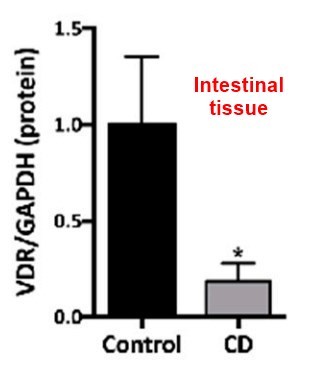Crohn’s Disease is associated with poor Vitamin D Receptor (many solutions)
Diminished Vitamin D Receptor Protein Levels in Crohn’s Disease Fibroblasts: Effects of Vitamin D
Nutrients 2020, 12(4), 973; https://doi.org/10.3390/nu12040973
Laura Gisbert-Ferrándiz 1,†OrcID,Jesús Cosín-Roger 2,†,Carlos Hernández 2OrcID,Dulce C. Macias-Ceja 2,Dolores Ortiz-Masiá 3,Pedro Salvador 1,Juan V. Esplugues 1,2OrcID,Joaquín Hinojosa 4,Francisco Navarro 4OrcID,Sara Calatayud 1OrcID andMaría D. Barrachina 1,*

📄 Download the PDF from VitaminDWiki
Vitamin D (VD) deficiency has been associated to Crohn’s disease (CD) pathogenesis, and the exogenous administration of VD improves the course of the disease, but the mechanistic basis of these observations remains unknown. Vitamin D receptor (VDR) mediates most of the biological functions of this hormone, and we aim to analyze here the expression of VDR in intestinal tissue, epithelial cells, and fibroblasts from CD patients. The effects of VD on a fibroblast wound healing assay and murine intestinal fibrosis are also analyzed. Our data show diminished VDR protein levels in surgical resections and epithelial cells from CD patients. In intestinal fibroblasts isolated from damaged tissue of CD patients, we detected enhanced migration and decreased VDR expression compared with both fibroblasts from non-damaged tissue of the same CD patient or control fibroblasts. Treatment with VD increased VDR protein levels, avoided the accelerated migration in CD fibroblasts, and prevented murine intestinal fibrosis induced by the heterotopic transplant model. In conclusion, our study demonstrates diminished VDR protein levels associated with enhanced migration in intestinal fibroblasts from damaged tissue of CD patients. In these cells, VD accumulates VDR and normalizes migration, which supports that CD patients would benefit from the VD anti-fibrotic therapeutic value that we demonstrate in a murine experimental model
